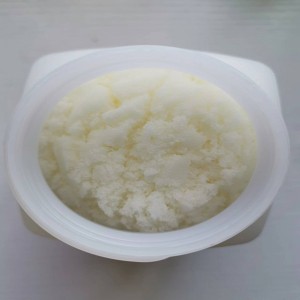Furan-2 5-dicarbaldehidă/CAS 823-82-5/2 5-diformilfuran/DFF
2,5-furandialdehidă (DFF) este unul dintre produsele intermediare ale oxidării selective a 5-hidroximetilfurfuralului și un compus important al platformei Furan,
DFF CAS 823-82-5 poate fi utilizat ca intermediar pentru a sintetiza diverși compuși cu valoare ridicată și utilizabili, incluzând intermediari farmaceutici, agenți antibacterieni, lianți, agenți fluorescenți, etc.
În plus, 2,5-furandialdehida poate fi, de asemenea, utilizată pentru a sintetiza diverse materiale polimerice noi, cum ar fi rășini noi pe bază de biomasă, materiale fluorescente, poliol și polietilenă.
Ambalat în 25 kg pe tambur sau pe baza cerințelor clienților.

Furan-2 5-dicarbaldehidă trebuie păstrat în condiții specifice pentru a-și menține stabilitatea și a preveni degradarea. Iată câteva orientări generale pentru stocarea acestui compus:
1. Container: Furan-2,5-dicarbaldehidă depozitați într-un recipient sigilat pentru a preveni expunerea la aer și umiditate pentru a evita oxidarea sau hidroliza.
2. Temperatură: Furan-2,5-Dicarbaldehidă depozitați compusul într-un loc rece, uscat, de preferință sub temperatura camerei. Evitați expunerea la surse de căldură.
3. Light: Evitați expunerea la lumină, deoarece unii compuși organici se vor degrada atunci când sunt expuși la raze UV.
4. Gaz inert: Dacă este posibil, păstrați sub un gaz inert, cum ar fi azot sau argon pentru a reduce la minimum oxidarea.
5. Etichetă: etichetați clar containerele cu nume chimice, concentrare și informații despre pericol.
6. Precauții de siguranță: Urmați toate orientările și reglementările relevante de siguranță pentru manipularea și stocarea substanțelor chimice, inclusiv utilizarea echipamentelor de protecție personală adecvate (PPE).
Furan-2,5-dicarbaldehidă este considerat a avea unele proprietăți periculoase, deși informațiile specifice pot varia în funcție de concentrație și expunere. Iată câteva puncte generale despre siguranța sa:
1. Toxicitate: poate fi dăunătoare dacă este ingerată, inhalată sau absorbită prin piele. Sunt recomandate manipularea atentă și utilizarea echipamentelor de protecție personală adecvate (PPE).
2. Iritare: Poate provoca iritații pielii, ochilor și tractului respirator.
3. Impactul asupra mediului: Ca mulți compuși organici, poate fi dăunător pentru viața acvatică și mediul înconjurător, dacă este eliberat în cantități mari.
4. Informații de reglementare: Consultați întotdeauna fișa de date de siguranță (SDS) și reglementările locale pentru orientările specifice de manipulare, depozitare și eliminare.










